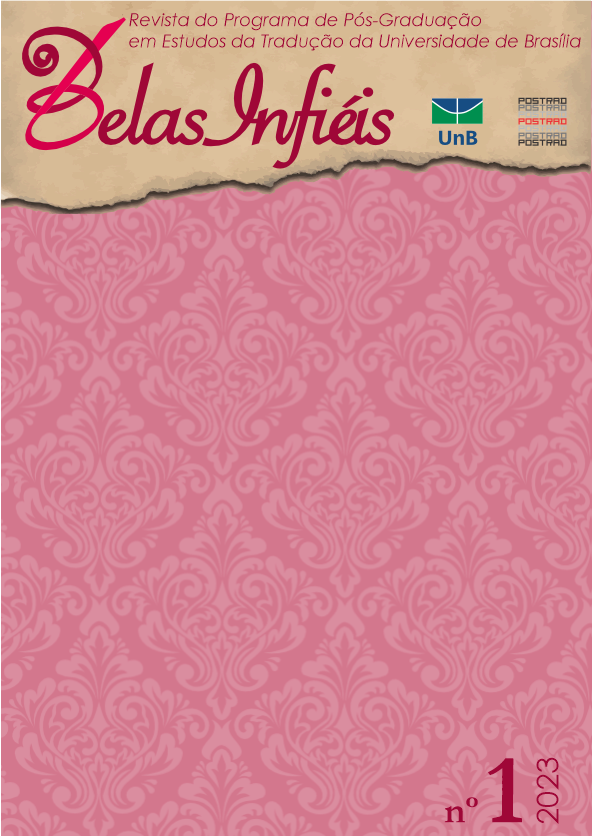Images in Picturebooks: Convergent or Divergent Identities?
DOI:
https://doi.org/10.26512/belasinfieis.v12.n1.2023.48179Keywords:
Translation of Children's Literature. Picturebooks. Visual Narratives. Identities. Piggybook. Clifford, the Big Red Dog.Abstract
The aim of this paper is to discuss the construction of meanings in picturebooks to possibly establish empathy with the prospective reader. As part of a broader study, its focus of interest is on Piggybook, by Anthony Browne, and Clifford, the Big Red Dog, by Norman Bridwell, and their translated versions into Portuguese, considering character design, in a perspective of complementarity between the two semiotic modes, image and verbiage (verbal language). In the translation of children's literature, most of the studies focus on character design and the effects they may have on choices made in translated texts, with a basis on arts studies. In linguistic studies, picturebooks have been examined from the perspective of sociosemiotics, based on the grammar of the visual which does not take into account images in a sequence. The present study is relevant because it is aimed at the construction of meanings in picturebooks and grounded in the translation of children’s literature, using as a method of analysis a sociosemiotic reading of visual narratives, i.e., images presented in a sequence. Considering complementarity relations of image and verbiage in the construction of meanings, the study suggests that different constructions have an effect on themes intertwined in Anthony Browne's Piggybook, and Norman Bridwell’s Clifford, the Big Red Dog.
Downloads
References
Alvstad, C. (2008). Illustrations and Ambiguity in Eighteen Illustrated Translations of Hans Christian Andersen’s “The steadfast Tin Soldier”. Meta, 53(1), 90–103.
Alvstad, C. (2010). Children’s Literature and Translation. In Y. Gambier, & L. van Doorslær (Orgs.), Handbook of Translation Studies (v. 1, pp. 22–27). John Benjamins Publishing Company.
Bridwell, N. (2010). Clifford, the Big Red Dog. Scholastic Inc.
Bridwell, N. (1995). Pacheco, o cachorro gigante (M. C. Machado, Trad., 6ª edição). Ediouro.
Browne, A. (1986). Piggybook. Dragonfly books.
Browne, A. (2013). O livro dos porquinhos (M. Mouro, & I. Buratti, Trads.; 2ª edição). Kalandraka Editora Portugal Ltda.
Hunt, P. (2010). Crítica, teoria e literatura infantil (C. Knipel, Trad.). Cosac Naify.
Kress, G., & van Leeuwen, T. (2006). Reading Images: The Grammar of Visual Design. (2nd edition). Routledge.
Magalhães, C. M., & Lee, I. B. (2022). A gradação da agência e emoção na construção da (in)segurança no livro ilustrado Into the Forest, de Anthony Browne, e sua tradução para o português. Cadernos de Tradução, 42, 1–39. https://doi.org/10.5007/2175-7968.2022.e82754
Nikolajeva, M., & Scott, C. (2011). Livro ilustrado: palavras e imagens (C. Knipel, Trad.). Cosac Naify.
Nikolajeva, M. (2014). Memory of the present: empathy and identity in young adult fiction. Narrative works: issues, investigations & interventions, 4(2), 86–107.
Nodelman, P. (1988). Words About Pictures: The Narrative Art of Children’s Picture Books. The University of Georgia Press.
Oittinen, R. (2000). Translating for Children. Taylor & Francis Group e-library.
O’Sullivan, E. (2006). Translating pictures: the interaction of pictures and words in the translation of picture books. In G. Lathey (Ed.), The Translation of Children’s Literature: A Reader (pp. 113–12). Multilingual Matters.
Painter, C., Martin, J. R., & Unsworth, L. (2013). Reading Visual Narratives: Image Analysis of Children’s Picture Books. Equinox.
Painter, C. (2018). Multimodal Analysis of Picturebooks. In B. Kümmerling-Meibauer (Ed.), The Routledge Companion to Picturebooks (pp. 420–428). Routledge.
Shavit, Z. (1986). Poetics of Children’s Literature. The University of Georgia Press.
Downloads
Published
How to Cite
Issue
Section
License
Copyright (c) 2023 CC BY

This work is licensed under a Creative Commons Attribution 4.0 International License.
Given the public access to this journal, the texts are free to use but requires the recognition of the original authorship and initial publication in this journal to be properly stated.
 The journal allows the use of works published for non-commercial purposes, including the right to submit the work to publicly accessible databases. Published contributions are the sole and exclusive responsibility of the author(s).Â



















